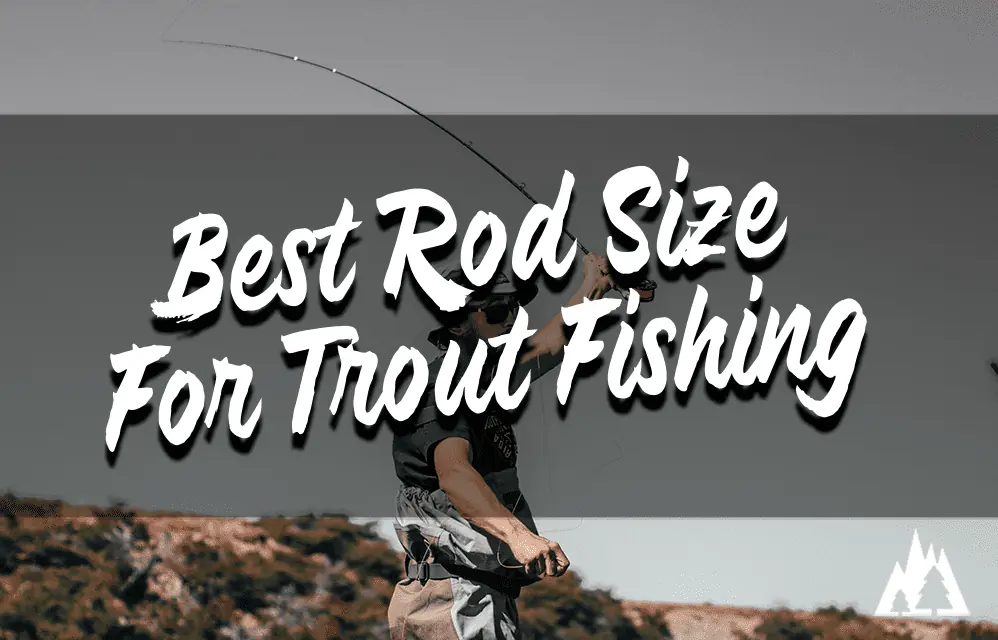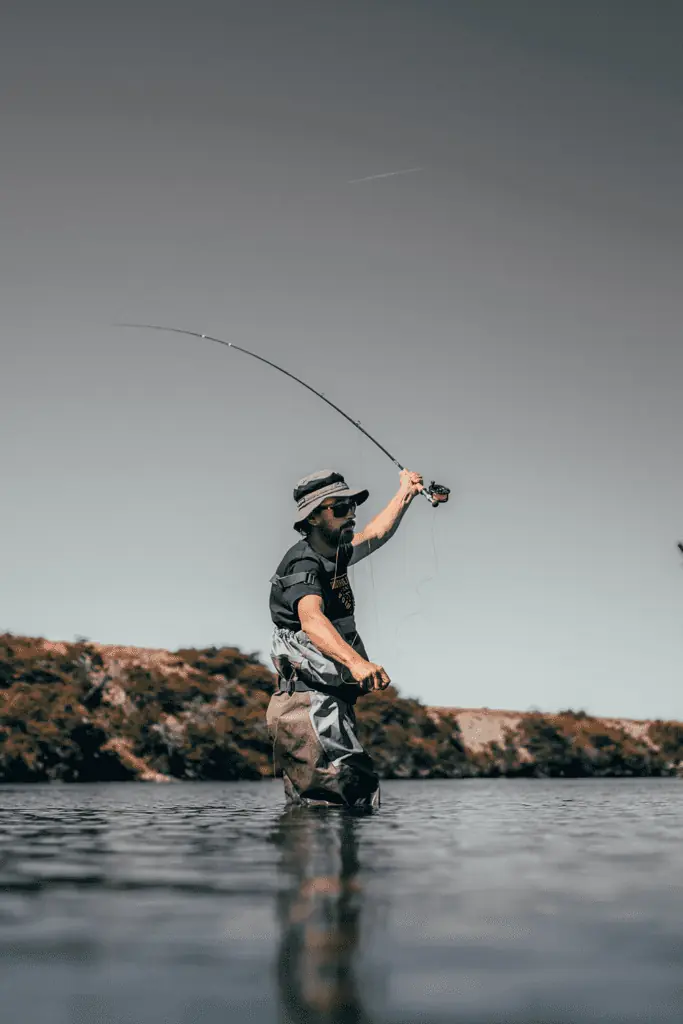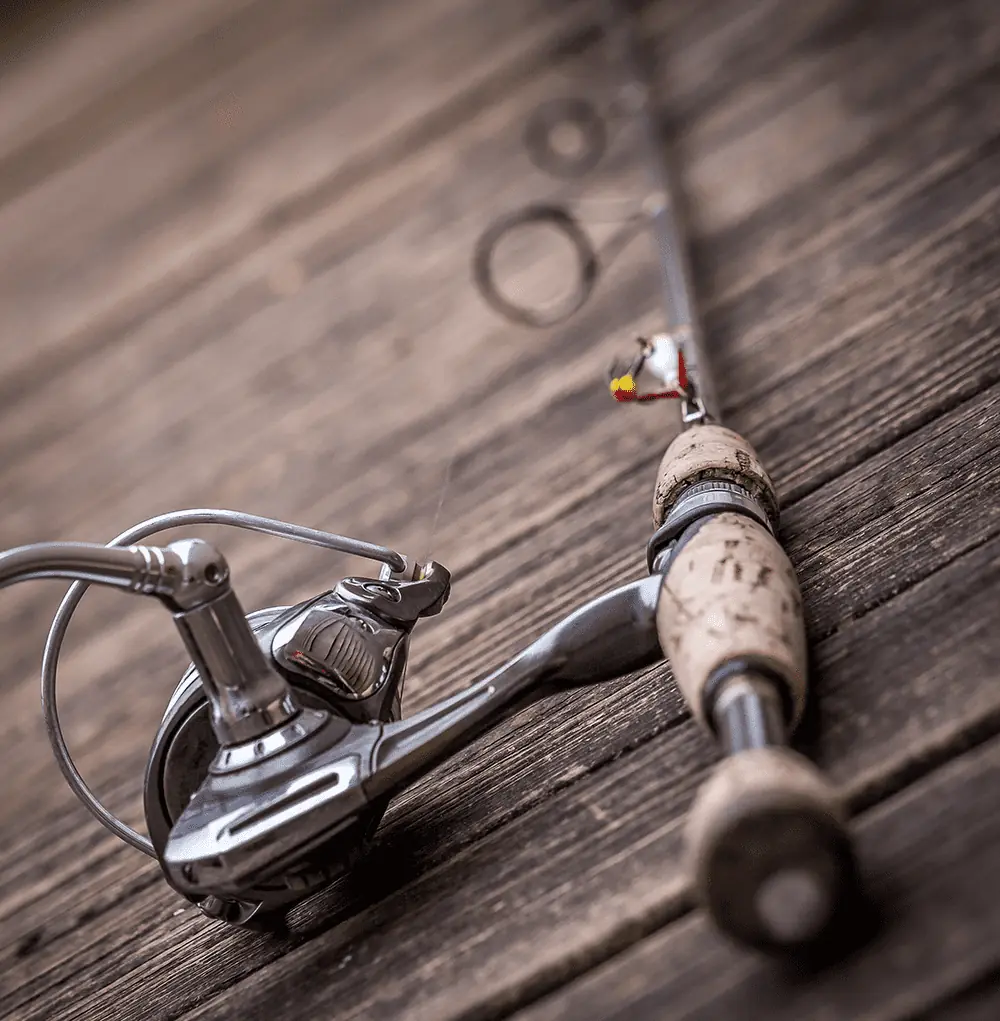What Size Rod Is Best For Trout Fishing? A Guide to Choosing The Right Setup

The best size rod for trout fishing depends on the type of trout setup you’re using. There are three main rod types that you can use to catch trout:
- 1. Ultralight spinning rods
- 2. BFS casting rods
- 3. Fly rods
The key to trout fishing is going lighter and smaller, most of the time.
Lighter line, smaller lures, ultralight spinning reels, and rods are basically what you’re aiming to look for.
Choosing the right size rod is essential for a successful day on the water.
With so many options, it can be hard to decide which rod size is best for trout fishing.
The answer isn’t as simple as you may think. Different rods have different lengths and actions that work better in certain situations.
I’ll break down all these components to give you insight into choosing the right trout fishing setup that suits your needs.
Rod Length
Whether you’re fly fishing in a stream or jig fishing at your local lake, rod length will vary in size.
Shorter people might prefer shorter trout rods and vice versa.
Maybe you want a short spinning rod to avoid shrubs and trees when casting.
Or maybe you want a longer rod to help improve casting distance.
Spinning Rods
Spinning rods are the most popular type of rod for trout fishing.
They’re super easy to use and a great introductory reel for children.
They come in various lengths, from short ultralight models to longer heavy-duty versions.
Short spinning rods are great for casting light lures and baits into tight spaces, while longer spinning rods provide more power and control when casting heavier lures or fighting larger fish.
When choosing a spinning rod length, consider the size of your target species and the type of water you’ll be fishing in.
Casting Rods
Casting rods offer greater accuracy than spinning rods because they allow anglers to make pinpoint casts with lighter lures or bait rigs.
These rods range from ultra-short “flippin’ sticks” designed for pitching baits into tight cover to long surfcasting models that can cast several hundred yards out into open water.
Your length will depend on where you plan to fish and what kind of lure or bait rig you intend to use.
Because of BFS fishing, you now have an option for an ultralight casting rod, something unheard of when I was a kid.
Fly Rods
Fly fishing is an art form that requires precision casting techniques, so fly fishermen typically prefer shorter rod lengths between 5–9 feet (1–2 meters).
Shorter fly fishing rods allow anglers to make delicate presentations with small flies while also providing enough power for accurate casts at medium distances, ideal conditions for targeting trout in rivers and streams.
Longer fly fishing rods can reach farther distances but lack the finesse needed when making close presentations with tiny flies such as midges or mayflies.

Rod Action
Fast-action rods are stiffer and have less flex when pressure is applied. They are designed for accuracy and distance casting, making them ideal for anglers who want to cast farther into the water.
These rods also provide more control over the lure or bait, allowing you to make subtle adjustments while fishing. When using a fast-action rod, it’s important to use lighter lures so that you don’t overpower your line or break off your hook.
Moderate-action rods offer a balance between flexibility and power. This rod type is great for beginners because it provides enough flexibility to learn how to cast without sacrificing too much power.
It also offers good sensitivity when feeling bites on the line and better accuracy than fast action rods due to its increased flex.
Slow-action rods are very flexible, with plenty of give when pressure is applied, making them perfect for anglers who prefer finesse techniques such as light jigging or trolling with small baits like worms or grubs.
The extra flex allows these types of lures to move naturally through the water, which can help attract more fish strikes than faster-moving lures would be able to do on their own. Slow-action rods also allow you greater control over your presentation since they bend further under load compared to other rod actions.
Line Weight
Light line weights are best suited for smaller fish like panfish or small trout. This line is typically between 2 and 6 pounds, making it ideal for light tackle fishing.
The lighter the line, the easier it is to cast and handle. It also allows you to feel more bites from smaller fish as they take your bait or lure.
When using light lines, use a rod with a soft tip so you can detect even the slightest nibble on your bait or lure.
Medium line weights are better suited for larger trout such as browns, rainbows, and brookies.
These lines range from 6-12 pounds in weight and provide enough strength to land bigger fish without sacrificing too much sensitivity when detecting bites.
If you’re targeting large trout in deeper water, then medium lines are recommended since they have more power than lighter lines but still allow you to feel subtle strikes from big fish.
Heavy line weights are best used when targeting large gamefish such as salmon or steelhead, which require strong gear due to their size and fighting ability.
Lines heavier than 12 pounds should only be used if necessary since they lack sensitivity compared to lighter lines but offer more strength when battling larger fish species like salmon or steelhead.
Your rod must have plenty of backbone to handle heavy loads without breaking under pressure during long fights with big gamefish.
When it comes to line weight, there is no one-size-fits-all answer. It all depends on the type of trout fishing you’re doing and the size of your rod. So the next step in choosing the right rod for trout fishing is understanding reel sizes and gear ratios.

Reel Size and Gear Ratio
Choosing the right size reel and gear ratio will help cast out smaller lures and retrieve them with optimal performance.
Spinning Reels and Gear Ratios
Spinning reels are the most popular type of reel for trout fishing. They come in a variety of sizes, from ultra-light to heavy-duty models. Your size will depend on the type of fish you’re targeting and how much line capacity you need.
Regarding gear ratios, spinning reels usually range from 4:1 up to 6:1; higher gear ratios mean faster retrieval speeds but lower torque power when fighting larger fish like salmon or steelhead.
For trout fishing, a 5:1 ratio is ideal as it provides enough speed for quick retrieves while still having plenty of torque power when needed.
Baitcasting reels are also popular among trout anglers because they offer more control over casting accuracy than spinning reels.
Like spinning reels, baitcasters come in different sizes depending on the species being targeted and the amount of line capacity needed; however, their gear ratios tend to be higher than those found on spinning reels—typically ranging from 7:1 up to 10:1—which makes them great for quickly retrieving lures or baits with minimal effort required by the angler.
Fly fishing requires specialized equipment that includes fly rods, lines, leaders, tippets, flies, and a fly reel which can be used both for storing your line and controlling drag during fights with large fish such as salmon or steelhead.
Fly fishing reels typically have low gear ratios (3-4:1), which allow anglers more control over their casts while still providing enough power when fighting bigger fish species. These low gear ratios allow anglers to set hooks properly before applying too much pressure on smaller species like trout, avoiding break-offs.
Choosing the Right Trout Fishing Setup for You
When it comes to choosing the right trout fishing setup for you, several factors need to be taken into consideration. First and foremost is your skill level and experience.
If you’re a beginner, you should opt for a moderate action and light-line weight rod. This will make casting easier while still providing enough power to handle larger fish when they strike.
On the other hand, if you’re an experienced angler looking for more of a challenge, fast-action rods with heavier line weights may be better suited for your needs.
Your budget is also important when selecting the right trout fishing setup. Generally speaking, higher quality rods tend to cost more but offer superior performance in terms of sensitivity and strength, making all the difference when trying to land big fish or fighting strong currents or winds.
However, if money is tight, opting for lower-priced models can still provide good results as long as they meet your specific requirements in terms of length, action type, and line weight.
Ultimately, no matter what kind of equipment or technique is used, success boils down to practice. So don’t forget to take time out regularly to hone those skills.
FAQs
What size rod and reel for trout fishing?
Generally speaking, a medium-light action spinning rod in 6 to 7 feet in length paired with a 2000 or 2500 series spinning reel is ideal for catching smaller species such as rainbow and brown trout.
For larger species like lake trout or steelhead, a medium-heavy action rod in 8 to 9 feet in length with a 3000 or 4000 series spinning reel will give you more power when casting and retrieving your bait.
Ultimately, choosing the right gear for your specific needs will help ensure that you have an enjoyable time out on the water.
Is a 5-6 rod good for trout?
Generally speaking, a 5-6 rod is suitable for smaller species such as brook and rainbow trout.
However, if you plan to fish larger species like brown or lake trout, then a longer rod with more backbone may be necessary to handle the heavier weight of these fish.
It’s important to consider the size and strength of your target species when selecting a rod to get the most out of your fishing experience.
Is a medium-heavy rod good for trout?
Yes, a medium-heavy rod is suitable for trout fishing. It provides the power to cast lures and bait further out into the water while still having enough sensitivity to detect subtle bites from smaller fish.
It has enough backbone to handle larger trout when they strike. A medium-heavy rod also allows you to use heavier line if needed, which can be beneficial in certain situations, such as fishing around structures or weeds.
What size rod for trout and bass?
A light to medium action rod with a length of 6-7 feet for trout is ideal.
The line weight should be 4-8 pounds. A medium-heavy or heavy-action rod with a length of 7-9 feet is best for bass.
Line weights should range from 10-20 pounds depending on the type of water you are fishing in and the fish you are targeting.
Both rods should have fast action tips allowing quick casting and retrieving when necessary.
Before You Go
Before you go, check out these other resources to help you catch more trout on your next day on the water:






